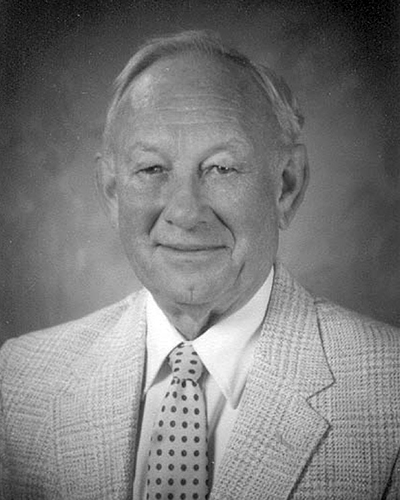Department Mourns the Loss of Professor Emeritus Jerald Ericksen

Jerald LaVerne Ericksen, Professor Emeritus in the Department of Aerospace Engineering and Mechanics and the School of Mathematics at the University of Minnesota, died June 11, 2021.
Jerry Ericksen was born on December 20, 1924 in Portland, Oregon, to Adolph and Ethel Ericksen during a bad winter storm. Adolph was skilled at making and judging butter and served as a foreman at large creamery in Portland. He was fired, as happened to many, when the depression hit. The family bought and revitalized a rundown creamery in Vancouver, Washington where Jerry worked hard during his youth.
Ericksen graduated from high school in the fall of 1942 and entered Oregon State College in Corvallis. He enlisted in the Navy after a year at Oregon State, and, to his surprise, was sent to train as an officer, first at Pocatello, Idaho and then at the University of Washington, Seattle. During training, he met Marion Pook. He served in the Pacific theater for the duration of the war, and they married on his return to the states.
On the GI bill, Jerry finished his undergraduate studies at the University of Washington in one year and received a bachelor’s degree with a major in mathematics and a minor in naval science. He moved to the Mathematics Department at the University of Oregon for a masters, but found the program lacking in applications of mathematics. His advisor, Howard Eves, told him of a new program at Indiana University that involved both serious mathematics and applications. He moved to Bloomington, Indiana, and finished his degree with David Gilbarg. During that time, partly inspired by a course given by Clifford Truesdell, he developed what turned out to be a lifelong interest in continuum mechanics, particularly in the discovery and formulation of continuum theories.
After earning a Ph.D. In mathematics at Indiana in 1951, Ericksen joined the U. S. Naval Research Laboratory, where he enjoyed significant freedom to pursue various topics of interest, and stimulation from Nemenyi, Toupin, Saenz, Serrin, Truesdell (as a frequent visitor), and Rivlin. In 1957, he joined the Mechanical Engineering department at Johns Hopkins University. He then moved to the Department of Aerospace Engineering and Mechanics (AEM) at the University of Minnesota Twin Cities, with a joint appointment in the School of Mathematics, in the early 1980s. While with AEM, he joined three other members of the National Academy of Engineering.
Ericksen was a central figure in the resurgence of interest in continuum mechanics in period from the late 1940s to the early 1970s, along with Rivlin, Truesdell and many others. He is particularly well known for formulating the dynamic theory of liquid crystals (with Frank Leslie), for his discovery of the universal deformations of elastic materials (``Ericksen’s problem’’), and for studies that elucidated the unusual behavior of non-Newtonian fluids. His work could be quite abstract, but it was often intimately related to experimental measurement.
Jerry loved discussing science and was exceptionally generous with his ideas. He is warmly admired by his former students, who often cite a lifelong influence of even brief remarks he made. However, after about 1960, he did not write jointly authored papers, either with colleagues or his PhD students.
In addition to membership in the NAE, Ericksen was abundantly honored for his contributions, among others, the Bingham medal from the Society of Rheology (1968), the Timoshenko Medal from the American Society of Mechanical Engineers (1979), and the Engineering Science Medal from the Society of Engineering Science (1987), and several honorary doctorates. Ericksen said, “While the honors are very nice in themselves, the approval of those that really understand some of my work is even more important to me.”
On retirement at 65, Jerry moved to a charming house on a lake in Florence, Oregon, not far from the ocean, where he made additional important contributions. He continued to enjoy his lifelong interests in nature and woodworking. The writer once visited Jerry; returning from a run to the ocean, he made the natural assumption that, to return, he should run perpendicular to the ripples in the sand caused by the wind. After a very long time, he finally realized that the wind in coastal Oregon comes from the north, not from offshore! Jerry loved that little conceptual mistake. He leaves two children, Lynn and Randy, and is preceded in death by his wife, Marion.
Richard D. James
July 7, 2021